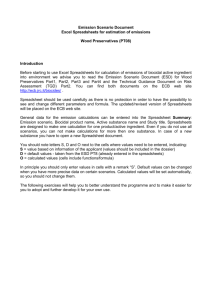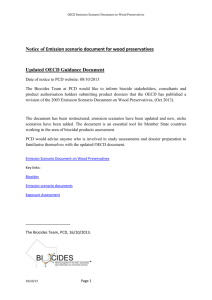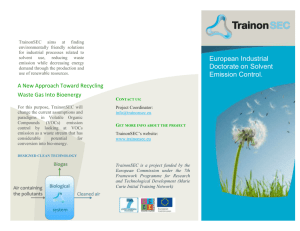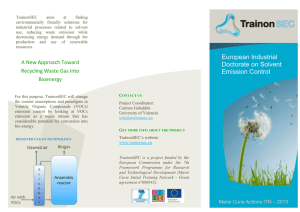Summary spreadsheet
advertisement
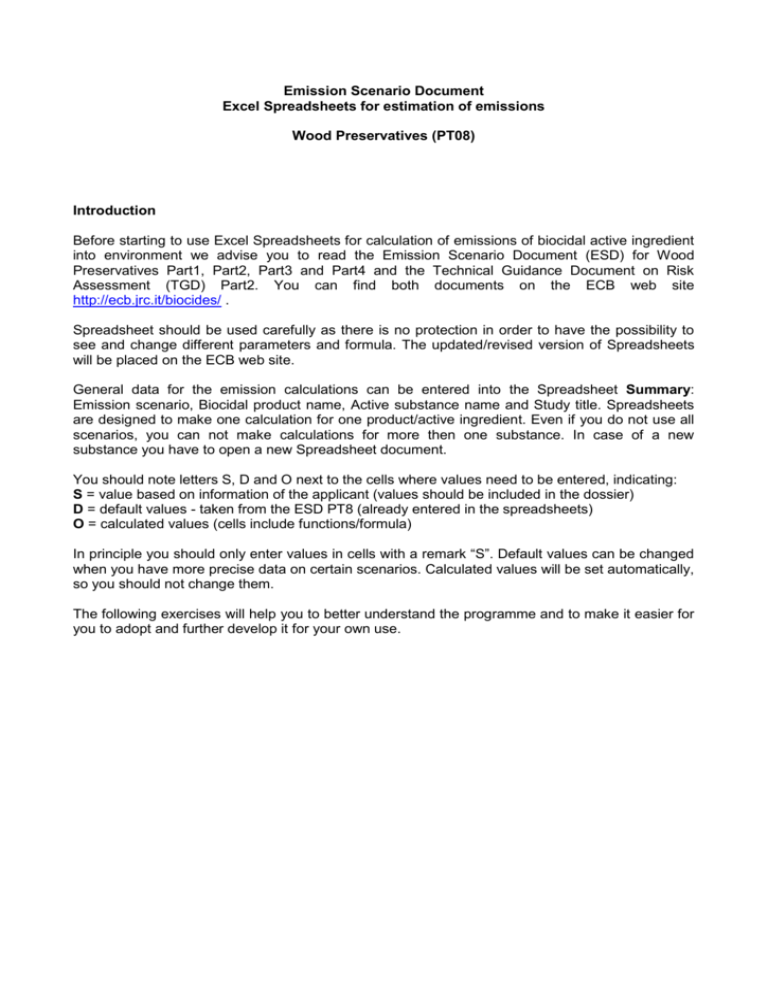
Emission Scenario Document Excel Spreadsheets for estimation of emissions Wood Preservatives (PT08) Introduction Before starting to use Excel Spreadsheets for calculation of emissions of biocidal active ingredient into environment we advise you to read the Emission Scenario Document (ESD) for Wood Preservatives Part1, Part2, Part3 and Part4 and the Technical Guidance Document on Risk Assessment (TGD) Part2. You can find both documents on the ECB web site http://ecb.jrc.it/biocides/ . Spreadsheet should be used carefully as there is no protection in order to have the possibility to see and change different parameters and formula. The updated/revised version of Spreadsheets will be placed on the ECB web site. General data for the emission calculations can be entered into the Spreadsheet Summary: Emission scenario, Biocidal product name, Active substance name and Study title. Spreadsheets are designed to make one calculation for one product/active ingredient. Even if you do not use all scenarios, you can not make calculations for more then one substance. In case of a new substance you have to open a new Spreadsheet document. You should note letters S, D and O next to the cells where values need to be entered, indicating: S = value based on information of the applicant (values should be included in the dossier) D = default values - taken from the ESD PT8 (already entered in the spreadsheets) O = calculated values (cells include functions/formula) In principle you should only enter values in cells with a remark “S”. Default values can be changed when you have more precise data on certain scenarios. Calculated values will be set automatically, so you should not change them. The following exercises will help you to better understand the programme and to make it easier for you to adopt and further develop it for your own use. Summary spreadsheet An overview of all calculations is presented in the Summary spreadsheet. Eight scenarios are included: Spraying, Dipping-immersion, House, Fence post, Transmission pole, Jetty in lake, Brushing house outdoor and Wharf. Detailed explanation for each scenario can be found in the ESD. I the Summary spreadsheet you should enter the general data regarding your evaluation: Biocidal product name, Active substance name and Study title. Save the document. Vapour pressure and Water solubility should also be entered into Summary spreadsheet. These entries will then appear in all spreadsheets. Note that units for water solubility are mg/l and not µg/l as in ESD. Specific data for an active substance are for example: – Vapour pressure: 0.001 Pa – Water solubility: 1 mg/l Enter these values. Values for emission factor to air (Fair) and emission factor to facility drain (Ffacilitydrain) will then be set automatically according to vapour pressure and water solubility values in all sheets where those factors are included. Automated spraying spreadsheet Specific data for a product are for example: – The density of the liquid product is 1 kg/l – Concentration of active substance in the product is 18.5 % – FLUXstorage-spray is 18.9 mg/m2 per day – 1 litre of the product should be used for impregnation of 1m2 of wood Enter these values and check also default values with values in ESD. You can find explanation for all terms/symbols in ESD Appendix 7. Exercise 1 Automated spraying spreadsheet Which result parameters will change when you change the vapour pressure? Enter that parameter into the third column of the table. Fill also the following results into the table. – What are the changes if the vapour pressure would be higher, for example 0.033 Pa? – Try also with other values: 0.12 Pa, 1.05 Pa, 2.1 Pa, 3 Pa and 1000 Pa. – Is total emission at storage affected by that change? Vapour pressure [Pa] 0.033 0.12 1.05 2.1 3 1000 Emission factor- Fair [--] 0.01 0.02 0.075 0.15 0.25 0.25 E-LOCALair [kg.d-1] 4.07 7.77 28.12 55.87 92.87 92.87 If the Vapour pressure is changed the emission factor Fair will change as well. The value that will change when Fair is changed is Emission to local air: E-LOCALair. Note that vapour pressure changes affect Fair only between 0,005 Pa and 2,5 Pa. Biocidal substances are intended to stay in wood as long as possible to protect it, so most of them are expected to have low vapour pressure. Total emission at storage is not affected by that change. The formula doesn’t include Fair. Anyway, the vapour pressure is considered as it affects the leaching in the test on the bases of which the FLUX value is calculated. Exercise 2 Automated spraying spreadsheet Which result parameters will change when you change the water solubility? Enter that parameter into the third column of the table. Fill also the following results into the table. – What are the changes if the water solubility would be lower, for example 0.000001 mg/l? – Try also with other values: 0.0004 mg/l, 0.03 mg/l, 0.065 mg/l, 0.2 mg/l and 100 mg/l. – Does the emission rate to surface water change? Water solubility [mg.l-1] 0.000001 0.0004 0.03 0.065 0.2 100 Emission factor- Ffcilitydrain [--] 0.0001 0.0015 0.003 0.015 0.03 0.03 E-LOCALfacilitydrain [kg.d-1] 0.037 0.555 1.11 5.55 11.1 11.1 If the Water solubility is changed emission factor to facility drain Ffacilitydrain is changed accordingly. The value that will change when Fair is changed is Emission to local facility drain: ELOCALfacilitydrain. Emission rate to surface is not affected by that change. The formula doesn’t include Ffacilitydrain. Anyway, the water solubility is considered at that calculation as it affects the leaching in the test on the bases of which the FLUX value is calculated. Exercise 3 Automated spraying spreadsheet Which are the changes in results if the value for time1 would be changed? – Is the value for time1 included in the formula for calculation of Local concentration in soil? – What is your explanation for that? If the time1 value were changed the Total emission at storage and Local concentration in soil would be changed. Time1 is not included directly in the formula to calculate the Local concentration in soil. It is included in the formula for calculation of Total emission at storage and the result of that calculation is included in formula for the estimation of Local concentration in soil. You can check the values included in the formula by clicking on the cell with the formula in it and then clicking on the formula bar. The name of the cells included will appear in colours and also the cells with the corresponding values will be framed with the same colour. Exercise 4 Automated spraying spreadsheet Is the emission rate to the surface water affected by the change of time1? – Is the value for time1 included in the formula for calculation of Emission rate to surface water? – Can you give an explanation for that? The emission rate to surface water is not affected by the time change as it is expressed in emissions per day. Time1 value is included in the formula but it is cancelled with time1 value from Qleach,storage,time1. Exercise 5 Dipping-immersion spreadsheet Check if all the data are entered. If not, first enter the missing data. Can you use the set (S) values from Automated spraying scenario? Data from Automated spraying scenario can not be used directly. Application rate should be calculated. See ESD Section 4.2.1.3., page 33. 1 litre of product corresponds to 1 kg of product when RHOproduct equals 1. Also VOLUME of wood treated should be calculated from AREA wood treated. For example AREA of wood treated 1000 m2 corresponds to VOLUME of 26.2 m3 wood treated. See ESD page 37. Anyway it is recommended to ask applicant to include into dossier product application rates for each scenario separately. Exercise 6 House spreadsheet Which values in spreadsheet House are affected if you change the time1 value? – What is your explanation for that? The change of time value in the cell does not affect any result. It should only be entered to indicate the duration of event also important for an overview in the Summary spreadsheet. But time parameter is involved in the Q*leach,time1 (cumulative quantity of an active ingredient leached out of 1 m2 of treated wood over the assessment period), so the effect of time should be seen from this value. It is important that you take into account the change of Q*leach,time1 when assessing the emissions for longer time periods. For that purpose the second sheet is included in spreadsheets for each scenario. All of them have a name of scenario with a number 2. Note that also Q*leach,time1 is changed to Q*leach,time2. Exercise 7 Automated spraying spreadsheet Include into the Spreadsheet the formula to calculate the concentration in local surface water: CLOCALsurfacewater,time1. You can assume that the surface water is a small creek with a flow rate of 0.3 m3/s. Use the formula from the ESD. The correct result is 0.0003 mg/l. Be sure that the set values (S) entered at the beginning of the exercise have not been changed. If so, you have to correct those values. Exercise 8 Summary spreadsheet The Vapour pressure value 0.1 Pa was measured at 25˚C instead of 20˚C as recommended. Can you estimate the value for the vapour pressure at the temperature 20˚C? The values at different temperature can be calculated using the formula in TGD, Part II in Chapter 2.3.2. The result is 0,07 Pa. In this case the change would not affect the emission factor Fair. Exercise A Product: Product A Product use: Insecticide and fungicide Active substance: Substance A (Inorganic borate) The quantity of active substance in the product is 20% Solvent: Ethylene Glycol Uses: Surface treatment to preserve new and existing timber against fungal decay and attack For wet rot and dry rot Joinery, Roof and Floor Timbers Suitable for interior and exterior application Properties: Vapour pressure: Water solubility: RHOproduct: Measured leaching rate at storage after automated spraying: < 9,9 x 10-11 Pa 95 g/l at 20˚C 1 kg/l 20 mg/m2 per day Application: Product A may be applied to bare wood by dipping, brushing or spraying 1 litre to 12-14 m2 (brush) 1 litre to 5 m 2 (spray) Questions: 1. Which application emission scenario(s) or wood-in-service should/could be used? The following scenario(s) could be used: – Application emission scenario: Automated Spraying can be used – Wood-in-service scenario: Brushing house outdoor. This scenario can be used if it can be verified by the applicant that leaching test results from sprayed wood are applicable also for wood after brushing. 2. Which are the values for emission factors Fair and Ffacilitydrain to be used in calculations? Fair is 0.001 as Vapour pressure is < 0.005 Pa. Ffacility drain is 0.03 as water solubility is > 0.1 mg/l. 3. What are the set/result values in your spreadsheet? Automated Spraying scenario: SET VALUES Qproduct-fluid [l.m-2] RHOproduct [kg.l-1] Cai [%] FLUXstorage,spray [mg.m-2.d-1] 0.2 1 20 20 RESULTS Emission to local air E-LOCALair [kg.d-1] Emission to facility drain E-LOCALfacility drain [kg.d-1] Total emission at storage Qleach,storage,time1[kg] Local concentration in soil C-LOCALsoil,time1 [mg.kgwwt-1] Emission rate to surface water E-LOCAL to surface water,time1 [kg.d-1] 0.16 2.4 0.52 19.41 0.009 Brushing house outdoor-application scenario: SET VALUES Qapplic,product [l.m-2] Cai [%] RHOproduct [kg.l-1] 0.2 20 1 RESULTS Esoil,brush,amateur [kg.d-1] Esoil,brush,professional [kg.d-1] 0.25 0.15 Local concentration in soil C-LOCALsoil1,leach,time,amat. [mg.kgwwt-1] Local concentration in soil C-LOCALsoil1,leach,time,prof. [mg.kgwwt-1] Local concentration in soil C-LOCALsoil2,leach,time,amat. [mg.kgwwt-1] Local concentration in soil C-LOCALsoil2,leach,time, prof. [mg.kgwwt-1] Local concentration in soil C-LOCALsoil3,leach,time,amat. [mg.kgwwt-1] Local concentration in soil C-LOCALsoil3,leach,time, prof. [mg.kgwwt-1] 1174.1223 704.4734 291.7834 175.07 56.5611 33.9367 Exercise B Product: Product B Product use: Protection against marine borer attack and decay Active substance: Substance B (oil born) The quantity of active substance in the product is 7.5% Uses: Product B may be applied to boat hulls, marine piles, jetty cross, landing steps Vapour pressure: Water solubility: RHOproduct: Cumulative quantity of active ingredient leached out of 1m2 of wood in 30 days: The half-life in water is 7 days. Properties: Application: 20 Pa 8.1 mg/l at 20˚C 1 kg/l 1006 mg/m2 Applied at pressures about 1400 kPa. Questions: 1. Which application emission scenario(s) or wood-in-service should/could be used? The following scenario could be used: – Wood-in-service scenario: Wharf The product is used for protection of wood against marine borer attack. 2. How the water solubility and vapour pressure affect the results? Water solubility and vapour pressure have no direct influence on calculated results as Fair and Ffacility drain are note taken into account. Anyway, both properties have strong effect on the leaching test result. Note that it is very important to know the time of the assessment for cumulative leaching quantity of active ingredient. 3. What are the result values in your spreadsheets? Wharf scenario: SET VALUES Q*leach,time1 [mg.m-2] Half-life in water [d] 1006 7 RESULTS Total emission during initial assessment period Qleach,time1[kg] per1/2day Local concentration in water C-LOCALseawater,leach,time1 [mg.m-3] Emission to water Ewater,leach,time1 [kg.d-1] per day 0.005 0.083 0.01 Taking removal processes in consideration: Local concentration in water C-LOCALseawater,time1 [mg.m-3] 0.041
